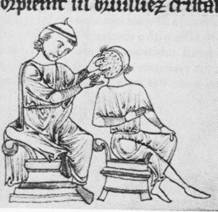Zombies are now a horror staple that spans mediums, and justly so. Zombies combine our intellectual fear of social decay and loss of self with our instinctual horror at the notion of a disease that rots flesh and threatens to consume anyone who dares go near those suffering from it. As contamination spreads, the disease threatens to overwhelm the medical systems which attempt to stand in its way, taxing and eventually exhausting human resources, medicine, and scientific knowledge.
Deep at the heart of what makes zombies send chills up our spines is the knowledge that such a disease is not, in fact, so farfetched.
Indeed, at a not-so-distant point in our past, a disease with striking physiological and narrative parallels to popular zombie myths did exist, and at times its population of sufferers seemed as vast as an apocalyptic zombie horde.
Consider leprosy. In the middle ages, the textual depictions of leprosy acquired depth, providing textured, gut-twisting descriptions in medical texts. The sordid details weren’t for entertainment; they were descriptive diagnostic tools intended to give physicians help in identifying, categorizing, and recommending appropriate palliative care for lepers, who were, once diagnosed, condemned to endure their incurable condition and a new position in society as one of the ‘dead.’
Avicenna described leprosy as cancer of the whole body. The leprosy we know today is caused by the bacteria Mycobacterium leprae and Mycobacterium lepromatosis. It is often called Hansen’s disease, after physician Gerhard Armauer Hansen, who identified M. leprae in 1873.
But the medieval doctor relied only on visible symptoms, and in the case of leprosy, these were highly variable and often masqueraded as other diseases. Addressing this difficulty, Gilbert the Englishman, alive during the late 12th and early 13th centuries, included the diagnostic symptoms of leprosy in his Compendium of Medicine. In his pursuit of detail, we find unintentionally chilling prose that wouldn’t be out of place in something Lovecraftian.
The skin would become “lucid…stretched into a similitude to very thin, polished leather.” The joints would become distorted, a symptom “preceded by a tickling sensation, as if some living thing were fluttering about within the body, the thorax, the arms, or the lips.” Blood drawn from the leper would prove to be thick, fetid, and full of granules. The whites of a leper’s eyes would become lined in red, as the eyeballs themselves appeared to protrude from their sockets.
In the 14th century, Jordanus de Turre corroborated these clinical realities. The leper’s fingertips would lose sensation. The little finger was the first to go, but the numbness would spread to every extremity. White corpuscles would cover the tongue, and the scalp would become lumpy. The cartilage of the nose would be slowly eaten away from the inside, causing it to sink into the face, and the sufferer’s hair on both the body and head would fall out. If it grew back at all, it would be in the form of small, straight hairs barely visible in sunlight, “like pigs’ bristles.”
Although their accounts were graphic in the service of medicine, it was not medieval authors who built a zombie legend out of the disquieting medical realities of the leper’s existence. Many people, like physicians, creatives, and missionaries, had something to gain (or certainly nothing to lose) by playing up the severity of leprosy on an individual and societal level. “With a drop of blood from this little finger,” says a leprous little girl in Henri Bataille’s late 19th-century play, La lépreuse, “I can kill a hundred, I can kill a thousand.” The disease itself could not spread that fast in the flesh, but it certainly did in the 19th-century imagination.
It has fallen to historians to dig out the truth and resurrect the historical medical realities of the leper, and Carole Rawcliffe has contributed a big shovel — Leprosy in Medieval England (2006). Her account, like others, suggests that it is difficult to substantiate a medieval paranoia or horror of lepers, or the ways it may have manifested, such as in legal evictions of lepers from cities, or restrictions of their movement within those cities. In the middle ages, the typical lazar house may have been more of a monastery or hospice than an isolated stronghold.
With zombies stepping in this century as our fictionalized symbols of epidemic disaster, the complex and intriguing social and medical history of the leper – more Shaun of the Dead than Dawn of the Dead – can be slowly but surely decoded and viewed through a lens wiped clean of the fog of popular fiction. Good news for the nearly 200,000 sufferers of leprosy that exist today.
Marri Lynn holds an MA in the History of Medicine at McGill University, Montreal (2011). She is currently studying French, while freelancing as a writer and copy editor. You can find out more at her About.me page.

